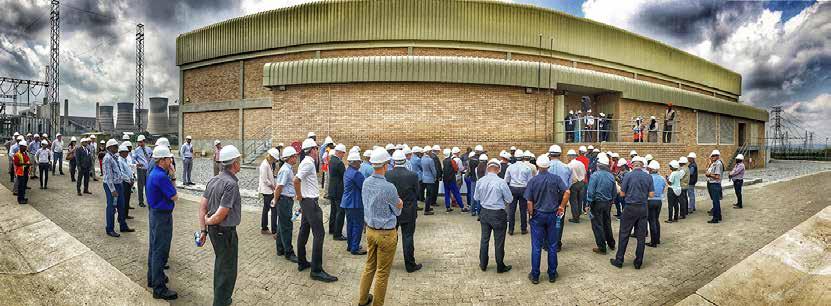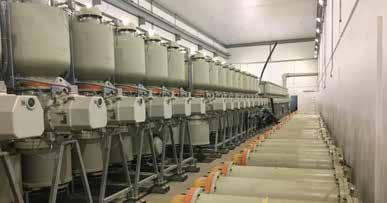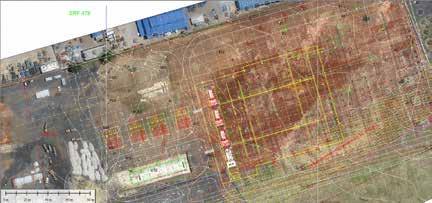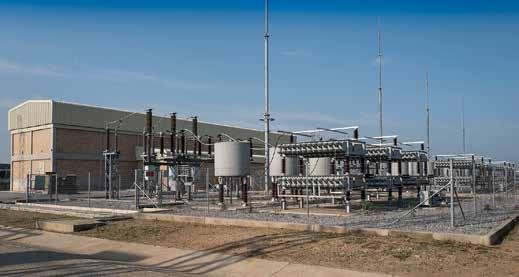
5 minute read
Lighting up one of Africa’s gr eatest cities
from IMIESA July 2020
by 3S Media
Lighting up one of Africa’s greatest cities

Advertisement
Within the world of construction, the fact that designs and their ensuing execution last well beyond their planned life is testimony to value engineering. The design and construction of the 1 400 MVA Sebenza substation for City Power serves as a classic example of an intervention that extends the functionality of 1960s era electrical architecture.
As a starting point, City Power’s Sebenza substation is a vital link in ensuring sustained 24/7 transmission. Once fully commissioned, Sebenza replaced the older Kelvin substation in supplying a large portion (the eastern third) of the City of Johannesburg via a bulk power line corridor consisting of 16 power line circuits.
GIS building showing the back view of the installed 38 bay GIS switchgear

Sebenza has the equivalent capacity to supply an estimated 700 000 households, in the process unlocking industrial, commercial and residential development. The process of implementing it was the responsibility of the PSW Nyeleti JV.
“The key achievement was that the project team successfully constructed and incorporated Sebenza into the City Power network, while maintaining supply to existing customers, catering for the additional load growth during the project, and keeping within City Power’s allocated budget,” says Juan-Dirk Voigt, director, PSW.
Key elements within the project scope included the transfer of 2 x 275 kV and 16 x 88 kV existing power lines, while catering for the restrictions and limitations presented by the existing Eskom and City Power network.
Not only did the Sebenza substation need to cater for the future 400 kV infeeds from Eskom, but also the integration and connection of the existing 300 MW Kelvin Power Station while in operation.
The old network
Kelvin Power Station is an old (privately owned) power station dating back more than 50 years. Over this time, the load demand had grown to the present ≈450 MVA threshold, exceeding the 300 MVA capacity available.
Geotech image showing the Sebenza substation footprint

The three installed 315 MVA transformers at Sebenza substation, manufactured by Actom Power Transformers in Wadeville

To meet the increasing demand and load growth, the 300 MVA capacity at Kelvin was supplemented by the existing Prospect bulk infeed substation, located in the far southeast of Johannesburg, via a double-circuit 88 kV transmission line, constructed during the mid-1960s. This resulted in constraints on the available generation and sporadic overloading of the available transformer capacity at Prospect, placing the electrical supply to the whole city at risk.
PSW was appointed in 2007 to conduct a feasibility study on the optimal positioning for the proposed new infeed substation. Several alternative positions and substation configurations were considered during this study. PSW was subsequently appointed in 2010 for the detail design, documentation and procurement phases.
Land space challenges
The required land area for a traditional outdoor transmission substation meeting all the stated requirements amounted to an estimated 10 to 11 hectares. The available land within close proximity to both Kelvin power station and the existing 88 kV power line corridor was limited to only 5.8 hectares. “The most critical engineering challenge of the Sebenza project was to balance and integrate the needs of all the related parties into a single bulk infeed substation, on a relatively small site and at a reasonable cost,” explains Pine Pienaar, CEO, Nyeleti Consulting.
The appointed contractor was Consolidated Power Projects, which finalised all works at the end of 2018. Remarkably, over the four-year construction programme almost 1 000 000 man-hour major-injury-free incidences were record.
Eskom’s confirmed requirements entailed a total of 12 x 400 kV switch bays to cater for four incoming circuits, two outgoing circuits, four transformer circuits to City Power, and space for two future generator circuits from Kelvin.
Due to the limited land area, Eskom agreed that a breaker-and-a-half fully outdoor scheme could be adopted to achieve the most compact design layout for the required 400 kV double bus-bar switchyard. Although the yard had to be designed and constructed at 400 kV to cater for Eskom’s future needs, the substation would be operated at 275 kV for the short to medium term.
With the two 275 kV, 630 MVA overhead line feeders from Prospect substation approaching Sebenza substation from the south, crossing the 16 existing outgoing circuits in the power line corridor to the city became unavoidable. In order to eliminate the need to turn the entire city off to establish this essential crossing, the design was adapted to allow for two

275 kV, 630 MVA underground interconnector cable feeders over an average distance of approximately 250 m, crossing underneath these existing circuits, from a new 275 kV line-to-cable transition yard into the highvoltage switchyard.
Because of the relatively compact design of the new technology SF6 GIS switchboard, the incoming and outgoing overhead line circuits, with their much larger electrical clearances, could not practically be terminated directly into the switchgear. It thus became essential to allow for the 132 kV underground interconnector cable feeders between the new GIS board, the 132 kV line-to-cable transition yard, and the several main substation components.
Self-build approach
Budget constraints at Eskom delayed the project going ahead on the Eskom side; however, in order to meet their load growth and maintain network stability, City Power could not delay. Subsequently, Eskom approved City Power’s application to ‘selfbuild’ a major component of the 400 kV switchyard. Sebenza thus became the first self-built Eskom transmission project in the country.
City Power confirmed the requirement for the substation design to provide for 4 x 315 MVA, 275/88 kV power transformers, fully controllable by City Power itself, for its short- to medium-term needs, to ensure the required future 1 000 MVA capacity under the N-1 configuration. It was decided that only three of the final four transformers would be installed during the first phase of the substation development.
“Either way, not only the transformer enclosures, but the complete substation, have been designed and constructed to cater for future planned upgrades,” Voigt concludes.










